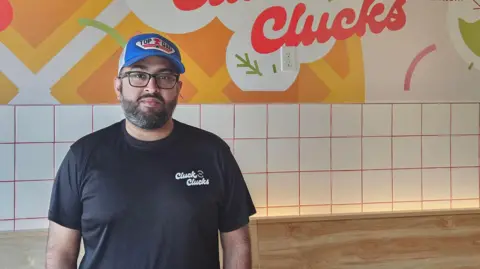How tariffs are shifting global supply chains

A 90-day pause on Donald Trump’s sweeping tariffs plan is about to expire on Wednesday, which could upend US trading relationships with the rest of the world. But the uncertainty of the last few months has already forced several companies to rethink their supply lines in radical ways.
When an Illinois toymaker heard that Trump was introducing tariffs on Chinese imports, he was so incensed that he decided to sue the US government.
“I’m inclined to stand up when my company is in genuine peril,” says Rick Woldenberg, who is the CEO of educational toy firm Learning Resources.
The majority of his company’s products are made in China, so the tariffs, which US importers have to pay, not Chinese exporters, are now costing him a fortune.
He says his import taxes bill leapt from around $2.5m (£1.5m) a year to more than $100m in April when Trump temporarily increased tariffs on Chinese imports to 145%. That would have “devastated” the company, he says.
“This kind of impact on my business is just a little bit hard to wrap my mind around,” he says.
With US tariffs on Chinese imports now at 30%, that’s still unaffordable for many American companies such as Learning Resources.
So in addition to its continuing legal fight, it is changing its global supply chain, moving production from China to Vietnam and India.
These two countries, like most others around the world, have seen the US hit them with general 10% tariffs, two-thirds lower than those on China. Although these 10% tariffs are due to run out on Wednesday, 9 July, uncertainly remains over what they may be replaced by.
Meanwhile, many Canadian companies, who often trade in both their home country and in the US, are now facing a double hit to their supply chains.
These hits are the 25% tariffs put in place by Trump on many Canadian imports, and the reciprocal ones of the same level that Canada has placed on a host of American exports.
And other businesses around the world are looking at exporting less to the US, because their American import partners are having to put up prices to cover the tariffs they now have to pay, which makes their products more expensive on US shelves.
At Learning Resources, Mr Woldenberg has now moved about 16% of manufacturing to Vietnam and India. “We have gone through the process of vetting the new factories, training them on what we needed, making sure that things could flow easily, and developing relationships.”
Yet he admits that there are uncertainties: “We don’t know if they can handle the capacity of our business. Much less the whole world moving in there at the same time.”
He also points out that switching production to another country is expensive to organise.
In the meantime, his legal case against the US tariffs, called “Learning Resources et al v Donald Trump et al” is continuing its way through the US court system.
In May a judge at the US District Court in Washington DC ruled that the tariffs against it were unlawful. But the US government immediately appealed, and Learning Resources still has to pay the tariffs for the time being.
So the firm is continuing to move production away from China.
 Learning Resources
Learning ResourcesGlobal supply chain expert Les Brand says that it is both expensive and difficult for companies to switch manufacturing to different countries.
“Trying to find new sources for critical components of whatever you are doing – that’s a lot of research,” says Mr Brand, who is CEO of advisory firm Supply Chain Logistics.
“There’s a lot of quality testing to do it right. You have to spend the time, and that really takes away from the business focus.”
He adds: “The knowledge transfer to train a whole new bunch of people on how to make your product takes a lot of time and money. And that effects already razor-thin margins businesses have right now.”
For Canadian fried chicken chain Cluck Clucks, its supply chain has been significantly impacted by Canada’s revenge tariffs on US imports. This is because while its chicken is Canadian, it imports both specialist catering fridges and pressure fryers from the US.
While it can’t live without the fridges, it has decided to stop buying any more of the fryers. Yet with no Canadian company making alternative ones, it is having to limit its menus at its new stores.
This is because it needs these pressure fryers to cook its bone-in chicken pieces. The new stores will instead only be able to sell boneless chicken, as that is cooked differently.
“This was a substantial decision for us, but we believe it’s the right strategic move,” says Raza Hashim, Cluck Clucks CEO.
“It’s important to note that we do plan to retain the necessary kitchen space in new locations to reintroduce these fryers should the tariff uncertainty be completely resolved in the future.”
He also warns that with the US fridges now more expensive for the company to buy, the price it charges for its food will likely have to go up. “There is a certain amount of costs we cannot absorb as brands, and we may have to pass those on to consumers. And that is not something we want to do.”
Mr Hashim adds that the business is continuing with its US expansion plans, and it has set up local supply chains to source American chicken. It currently has one US outlet, in Houston, Texas.
 Cluck Clucks
Cluck ClucksIn Spain, olive oil producer Oro del Desierto currently exports 8% of its production to the US. It says that the US tariffs on European imports, presently 10%, are having to be passed on to American shoppers. “These tariffs will directly impact the end consumer [in the US],” says Rafael Alonso Barrau, the firm’s export manager.
The company also says it is looking at potentially reducing the volume it sends to the US, if the tariffs make trading there less profitable, and exporting more to other countries instead.
“We do have other markets where we can sell the product,” says Mr Barrau. “We sell in another 33 markets, and with all of them, and our local market, we could cushion US losses.”
Mr Brand says that firms around the world would have been less impacted if Trump had moved more slowly with his tariffs. “The speed and velocity of these decisions are really making everything worse. President Trump should have gone slower and been more meaningful about these tariffs.”
Back in Illinois, Mr Woldenberg is also concerned about where Trump will go next in his trade battles.
“We just have to make the best decision we can, based on the information we have, and then see what happens,” he says.
“I don’t want to say ‘hope for the best’, because I don’t believe that hope is a strategy.”
Comments (0)